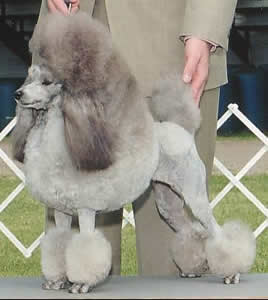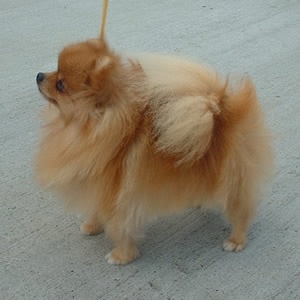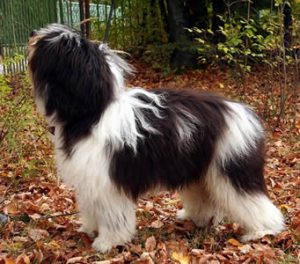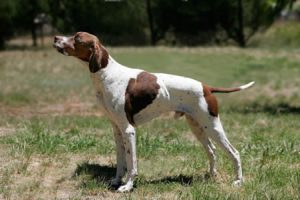
The Portuguese Water Dog is a breed of working dog as classified by the American Kennel Club. Portuguese Water Dogs are originally from the Portuguese region of the Algarve, from where the breed expanded to all around Portugal’s coast, where they were taught to herd fish into fishermen’s nets, to retrieve lost tackle or broken nets, and to act as couriers from ship to ship, or ship to shore. Portuguese Water Dogs rode in bobbing fishing trawlers as they worked their way from the warm Atlantic waters of Portugal to the frigid fishing waters off the coast of Iceland where the fleets caught cod to bring home. Portuguese Water Dogs were often taken with sailors during the Portuguese discoveries.
In Portugal, the breed is called Cão de Água (pronounced Kow-de-Ah-gwa; literally “water dog”. In its native land, the dog is also known as the Algarvian Water Dog (“Cão de Água Algarvio”, or Portuguese Fishing Dog (Cão Pescador Português). Cão de Água de Pêlo Ondulado is the name given the wavy-haired variety, and Cão de Água de Pêlo Encaracolado is the name for the curly-coated variety.
The Portuguese Water Dog is a fairly rare breed; only 15 entrants for Portuguese Water Dogs were made to England’s Crufts competition in 2002. Though some breeders claim they are a hypoallergenic dog breed, there is no scientific evidence to support the claim that hypoallergenic dog breeds exist. However, their non-shedding qualities have made them more popular in recent years.
Description
The closest relatives of the PWD are widely thought to be the Barbet and Standard Poodle. Like Poodles and several other water dog breeds, PWDs are highly intelligent, can have curly coats, have webbed toes for swimming, and do not shed. However, Portuguese Water Dogs are more robustly built, with stout legs, and can have a wavy coat instead of tightly curled. If comparing the structure to that of a Poodle, there are significant differences between the two breeds. The Portuguese Water Dog built of strong substantial bone; well developed, neither refined nor coarse, and a solidly built, muscular body. The Portuguese Water Dog is off-square, slightly longer than tall when measured from prosternum to rearmost point of the buttocks, and from withers to ground. Portuguese Water Dog eyes are consistently black, and their coats can be black, brown, black and white or brown and white.
Male Portuguese Water Dogs usually grow to be about 20 to 23 inches (51 cm to 58 cm) tall, and they weigh between 40 and 60 pounds (18 kg to 27 kg), while the females usually grow to be about 17 to 21 inches (43 cm to 53 cm) tall, and they weigh between 35 and 50 pounds.
PWDs have a single-layered coat that does not shed, and therefore their presence is tolerated extremely well among many people who suffer from dog allergies. Some call PWDs hypoallergenic dogs, but any person with dog allergies who seeks a dog with these qualities should actually spend time with the animals before purchasing, to test whether the dog is truly non-allergenic to them.
Most PWDs, especially those shown in conformation shows, are entirely black, black and white, brown, or silver-tipped; it is common to see white chest spots and white paws or legs on black or brown coated dogs. “Parti” or “Irish-marked” coats, with irregular white and black spots, are rare but visually striking. “Parti” dogs are becoming more common in the United States. However, in Portugal the breed standard does not allow more than 30% white markings. Overall, white is the least common Portuguese Water Dog colour, while black with white markings on the chin (“milk chin”Wink and chest is the most common colour combination.
Temperament
Portuguese Water dogs make excellent companions. They are loving, independent, and intelligent and are easily trained in obedience and agility skills. Once introduced, they are generally friendly to strangers, and enjoy being petted, which, due to their soft, fluffy coats, is a favour that human beings willingly grant them.
Because they are working dogs, PWDs are generally content in being at their master’s side, awaiting directions, and, if they are trained, they are willing and able to follow complex commands. They learn very quickly, seem to enjoy the training, and have a long memory for the names of objects. They are generally considered too small to be used as service dogs or guide dogs for the blind, but they make unusually good therapy dogs and hearing dogs (assistance dogs for the deaf).
A PWD usually stays in proximity to its owners, indoors as well as outdoors. This is typical of the breed. Though very gregarious animals, these dogs will typically bond with one primary or alpha family member. Some speculate that this intense bonding arose in the breed because the dogs were selected to work in proximity to their masters on small fishing boats, unlike other working dogs such as herding dogs and water dogs that range out to perform tasks. In any case, the modern PWD, whether employed on a boat or kept as a pet or a working therapy dog, loves water, attention, and prefers to be engaged in activity within sight of a human partner. This is not a breed to be left alone for long periods of time, indoors or out.
As water dogs, the PWD’s retrieving instinct is strong, which also gives some dogs tugging and chewing tendencies.
A PWD will commonly jump as a greeting. Owners may choose to limit this behaviour. Some PWDs may walk, hop, or “dance” on their hind legs when greeting or otherwise enthusiastic. Some PWDs will stand upright at kitchen counters and tables, especially if they smell food above them. This habit is known as “counter surfing” and is characteristic of the breed. Although it can be a nuisance, many PWD owners evidently enjoy seeing their dogs walking, hopping, standing up, or “countering” and do not seriously discourage these activities.
While they are very good companions to people who understand what they need, Portuguese Water Dogs are not for everyone. Because of their intelligence and working drive, they require regular intensive exercise as well as mental challenges. They are gentle and patient — but not “couch potatoes”, and boredom may cause them to become destructive.
—————————————————————————————————————–
CARING FOR YOUR DOG NEWSLETTER – Delivered Directly To Your Inbox – Starting Immediately – SIGN UP FOR FREE TODAY
—————————————————————————————————————–




